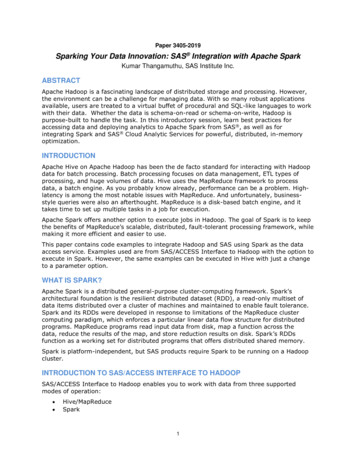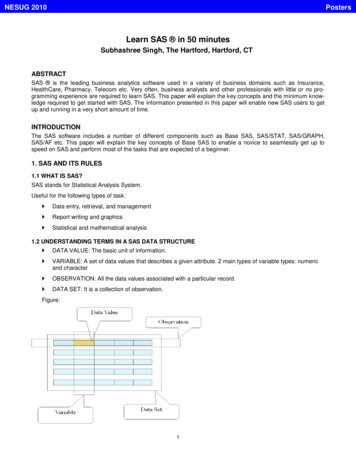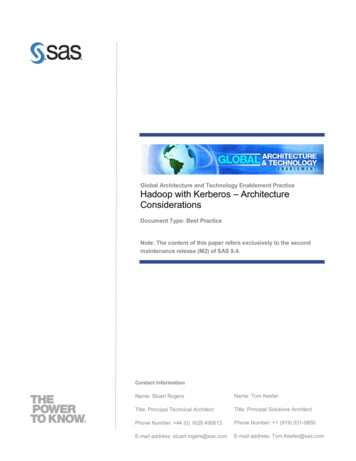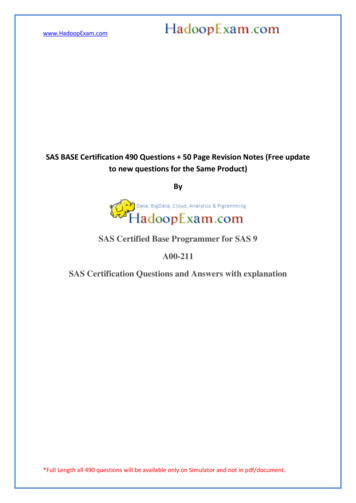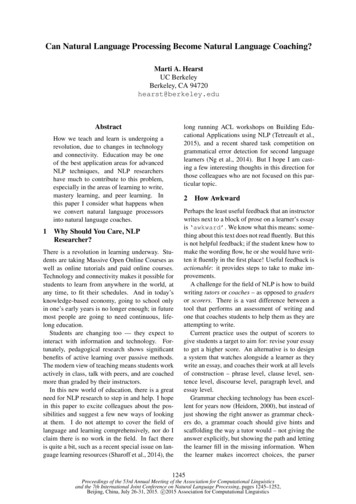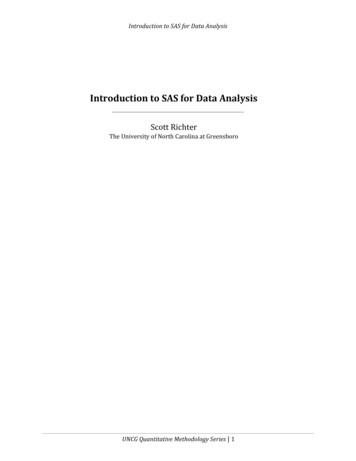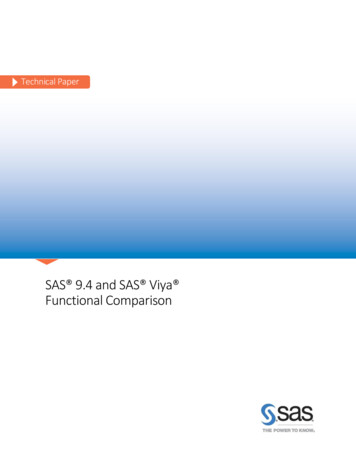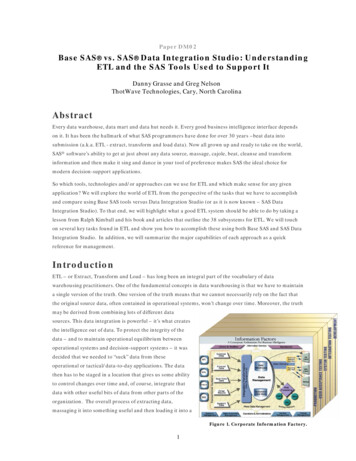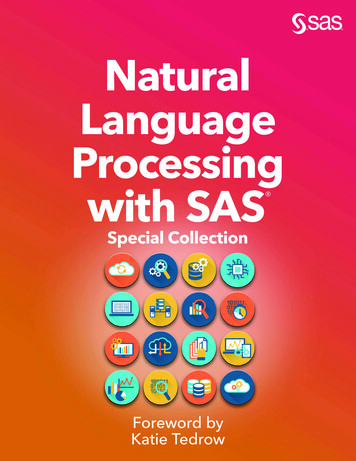
Transcription
The correct bibliographic citation for this manual is as follows: Tedrow, Katie. Natural Language Processing with SAS : SpecialCollection. Cary, NC: SAS Institute Inc.Natural Language Processing with SAS : Special CollectionCopyright 2020, SAS Institute Inc., Cary, NC, USAISBN 978-1-952363-18-4 (Paperback)ISBN 978-1-952363-16-0 (Web PDF)All Rights Reserved. Produced in the United States of America.For a hard-copy book: No part of this publication may be reproduced, stored in a retrieval system, or transmitted, in any formor by any means, electronic, mechanical, photocopying, or otherwise, without the prior written permission of the publisher,SAS Institute Inc.For a web download or e-book: Your use of this publication shall be governed by the terms established by the vendor at thetime you acquire this publication.The scanning, uploading, and distribution of this book via the Internet or any other means without the permission of thepublisher is illegal and punishable by law. Please purchase only authorized electronic editions and do not participate in orencourage electronic piracy of copyrighted materials. Your support of others’ rights is appreciated.U.S. Government License Rights; Restricted Rights: The Software and its documentation is commercial computer softwaredeveloped at private expense and is provided with RESTRICTED RIGHTS to the United States Government. Use, duplication, ordisclosure of the Software by the United States Government is subject to the license terms of this Agreement pursuant to, asapplicable, FAR 12.212, DFAR 227.7202-1(a), DFAR 227.7202-3(a), and DFAR 227.7202-4, and, to the extent required under U.S.federal law, the minimum restricted rights as set out in FAR 52.227-19 (DEC 2007). If FAR 52.227-19 is applicable, this provisionserves as notice under clause (c) thereof and no other notice is required to be affixed to the Software or documentation. TheGovernment’s rights in Software and documentation shall be only those set forth in this Agreement.SAS Institute Inc., SAS Campus Drive, Cary, NC 27513-2414August 2020SAS and all other SAS Institute Inc. product or service names are registered trademarks or trademarks of SAS Institute Inc. inthe USA and other countries. indicates USA registration.Other brand and product names are trademarks of their respective companies.SAS software may be provided with certain third-party software, including but not limited to open-source software, which islicensed under its applicable third-party software license agreement. For license information about third-party softwaredistributed with SAS software, refer to http://support.sas.com/thirdpartylicenses.
Table of ContentsForewordHow to Build a Text Analytics Model in SAS Viya with PythonBy Nate Gilmore, Vinay Ashokkumar, and Russell AlbrightHarvesting Unstructured Data to Reduce Anti-Money Laundering (AML) Compliance RiskBy Austin Cook and Beth HerronHearing Every Voice: SAS Text Analytics for Federal Regulations Public CommentaryBy Emily McRae, Tom Sabo, and Manuel FigalloMultilingual Sentiment Analysis: An RNN-Based Framework for Limited DataBy Ethem Can and Aysu Ezen-CanNLP with BERT: Sentiment Analysis Using SAS Deep Learning and DLPyBy Doug Cairns and Xiangxiang MengSound Insights: A Pipeline for Information Extraction from Audio FilesBy Dr. Biljana Belamarić Wilsey and Xiaozhuo Cheng
Free SAS e-Books:Special CollectionIn this series, we have carefully curated a collection of papers that introducesand provides context to the various areas of analytics. Topics coveredillustrate the power of SAS solutions that are available as tools fordata analysis, highlighting a variety of commonly used techniques.Discover more free SAS for additional books and resources.SAS and all other SAS Institute Inc. product or service names are registered trademarks or trademarks of SAS Institute Inc. in the USA and other countries. indicates USA registration.Other brand and product names are trademarks of their respective companies. 2017 SAS Institute Inc. All rights reserved. M1673525 US.0817
ForewordDid you know that unstructured text is the largest human-generated data source? Each day worldwide, we sendon average more than 500 million Tweets, about 5.5 billion SMS text messages, and over 281 billion emails.Tons of unstructured data is collected within organizations every day, too – from customer call logs, emails, socialmedia, surveys, product feedback, documents and reports, and so on. Often buried within that unstructured dataare rich insights that can help drive better business decisions, inform product strategy, and improve customerexperiences.This is where Natural Language Processing (NLP) comes in. NLP is an umbrella term used to describe a branch ofartificial intelligence that helps computers understand, interpret, and emulate written or spoken human language.NLP draws from many disciplines including human-generated linguistic rules, machine learning, and deep learningto fill the gap between human communication and machine understanding.NLP can be used to scale the human act of reading, organizing, and quantifying text data. Taking it a step further,NLP can empower conversational experiences, where a machine actually understands and responds and interactswith a user through natural language (often referred to as conversational AI). While this may sound futuristic,applying NLP to solve real business problems is becoming pervasive across industries, and new advancements arecontinuing to extend possibilities of what we can do with unstructured data.Several groundbreaking papers have been written to demonstrate these techniques and practical applications. Wehave carefully selected a handful of these from recent SAS Global Forum papers to introduce you to the topics andlet you sample what each has to offer. You will learn about the following: how NLP helps analysts combat anti-money laundering and fraud in the financial services industry. how NLP can help governments and policy makers in the rulemaking process by analyzing thousands ofcomments on proposed rules much faster and more accurately than would be possible manually. how to approach multilingual sentiment analysis when limited data is available. how to build text analytics models in SAS using open source, such as Python, to analyze product reviews. how to create your own BERT sentiment analysis model using SAS. how to extract hidden value from audio data using speech to text and machine learning to mine key voiceof customer insights.For an in-depth, technical understanding of text analytics and how to get started, I recommend reading SAS TextAnalytics for Business Applications: Concept Rules for Information Extraction by Teresa Jade, Biljana BelamaricWilsey, and Michael Wallis.The examples found in this e-book are from across industries and offer various business use cases to share aglimpse into how text analytics can be applied in your organizations. The beauty of NLP is that it has wideapplication – wherever there may be unstructured data, NLP can help discover opportunities and insights to drivedecisions.
vi Natural Language Processing with SAS: Special CollectionHow to Build a Text Analytics Model in SAS Viya with PythonBy Nate Gilmore, Vinay Ashokkumar, and Russell AlbrightPython is widely noted as one of the most important languages influencing the development of machine learningand artificial intelligence. SAS has made seamless integration with Python one of its recent focal points. With theintroduction of the SAS Scripting Wrapper for Analytics Transfer (SWAT) package, Python users can now easily takeadvantage of the power of SAS Viya. This paper is designed for Python users who want to learn more about gettingstarted with SAS Cloud Analytic Services (CAS) actions for text analytics. It walks them through the process ofbuilding a text analytics model from end to end by using a Jupyter Notebook as the Python client to connect to SASViya. Areas that are covered include loading data into CAS, manipulating CAS tables by using Python libraries, textparsing, converting unstructured text into input variables used in a predictive model, and scoring models. The easeof use of SWAT to interact with SAS Viya using Python is showcased throughout the text analytics model buildingprocess.Harvesting Unstructured Data to Reduce Anti-Money Laundering (AML) Compliance RiskBy Austin Cook and Beth HerronAs an anti-money laundering (AML) analyst, you face a never-ending job of staying one step ahead of nefariousactors (for example, terrorist organizations, drug cartels, and other money launderers). The financial servicesindustry has called into question whether traditional methods of combating money laundering and terrorismfinancing are effective and sustainable. Heightened regulatory expectations, emphasis on 100% coverage,identification of emerging risks, and rising staffing costs are driving institutions to modernize their systems. Onearea gaining traction in the industry is to leverage the vast amounts of unstructured data to gain deeper insights.From suspicious activity reports (SARs) to case notes and wire messages, most financial institutions have yet toapply analytics to this data to uncover new patterns and trends that might not surface themselves in traditionalstructured data. This paper explores the potential use cases for text analytics in AML and provides examples ofentity and fact extraction and document categorization of unstructured data using SAS Visual Text Analytics.Hearing Every Voice: SAS Text Analytics for Federal Regulations Public CommentaryBy Emily McRae, Tom Sabo, and Manuel FigalloRegulations.gov was launched in 2003 to provide the public with access to federal regulatory content and theability to submit comments on federal regulations. Public participation in federal rulemaking is encouraged as itsupports the legitimacy of regulatory decisions, frames public acceptance or resistance to rules underdevelopment, and shapes how the public interest will be served. Manually reading thousands of comments istime-consuming and labor-intensive. It is also difficult for multiple reviewers to accurately and consistently assesscontent, themes, stakeholder identity, and sentiment. Given that individually proposed rules can exceed 10,000comments, how can federal organizations quantitatively assess the data and incorporate feedback into therulemaking process as required by law?This paper shows how SAS Text Analytics can be used to develop transparent and accurate text models, and howSAS Visual Analytics can quantify, summarize and present the results of that analysis. This will significantlydecrease time to value, leveraging capabilities that computers excel at while freeing up human intuition for theanalysis of these results. Specifically, we will address public commentary submitted in response to new productregulations by the US Food and Drug Administration. Ultimately, the application of a transparent and consistenttext model to analyze these documents will support federal rule-makers and improve the health and lives ofAmerican citizens.
Foreword viiMultilingual Sentiment Analysis: An RNN-Based Framework for Limited DataBy Ethem Can and Aysu Ezen-CanSentiment analysis is a widely studied natural language processing task, whose goal is to determine users’opinions, emotions, and evaluations of a product, entity, or service that they review. One of the biggest challengesfor sentiment analysis is that it is highly language-dependent. Word embeddings, sentiment lexicons, and evenannotated data are language-specific. Furthermore, optimizing models for each language is very time-consumingand labor-intensive, especially for recurrent neural network (RNN) models. From a resource perspective, it is verychallenging to collect data for different languages.In this paper, we look for an answer to the following research question: Can a sentiment analysis model that istrained on one language be reused for sentiment analysis in other languages where the data are more limited?Our goal is to build a single model in the language that has the largest data set available for the task and reuse thatmodel for languages that have limited resources.For this purpose, we use reviews in English to train a sentiment analysis model by using recurrent neural networks.We then translate those reviews into other languages and reuse the model to evaluate the sentiments.Experimental results show that our robust approach of training a single model on English-language reviewsoutperforms the baseline in several different languages.NLP with BERT: Sentiment Analysis Using SAS Deep Learning and DLPyBy Doug Cairns and Xiangxiang MengA revolution is taking place in natural language processing (NLP) as a result of two ideas.The first idea is that pretraining a deep neural network as a language model is a good starting point for a range ofNLP tasks. These networks can be augmented (layers can be added or dropped) and then fine-tuned with transferlearning for specific NLP tasks. The second idea involves a paradigm shift away from traditional recurrent neuralnetworks (RNNs) and toward deep neural networks based on Transformer building blocks. One architecture thatembodies these ideas is Bidirectional Encoder Representations from Transformers (BERT). BERT and its variantshave been at or near the top of the leaderboard for many traditional NLP tasks, such as the general languageunderstanding evaluation (GLUE) benchmarks. This paper provides an overview of BERT and shows how you cancreate your own BERT model by using SAS Deep Learning and the SAS DLPy Python package. It illustrates theeffectiveness of BERT by performing sentiment analysis on unstructured product reviews submitted to Amazon.Sound Insights: A Pipeline for Information Extraction from Audio FilesDr. Biljana Belamarić Wilsey and Xiaozhuo ChengAudio files, like other unstructured data, present special challenges for analytics but also an opportunity todiscover valuable new insights. For example, technical support or call center recordings can be used for quicklyprioritizing product or service improvements based on the voice of the customer. Similarly, audio portions of videorecordings can be mined for common topics and widespread concerns. To uncover the value hidden in audio files,you can use a pipeline that starts with the speech-to-text capabilities of SAS Visual Data Mining and MachineLearning and continues with analysis of unstructured text using SAS Visual Text Analytics software. This pipelinecan be illustrated with data from the Big Ideas talk series at SAS, which gives employees the opportunity to sharetheir ideas in short, TED Talk–type presentations that are recorded on video. If you ever wondered what SASemployees are thinking about when they’re not thinking of ways to make SAS products better, the answers lie in apipeline for information extraction from audio files. You can use this versatile pipeline to discover sound insightsfrom your own audio data.We hope these selections give you a useful overview of the many tools and techniques that are available toincorporate analysis of unstructured text into your organization.
viii Natural Language Processing with SAS: Special CollectionKatie Tedrow is a Global Product Marketing Manager for AI at SAS. In herrole, she leads product marketing for Natural Language Processing with aspecialization in text analytics, conversational AI, and chatbots, inaddition to Business Intelligence and Visual Analytics. Katie is a strategicmarketer with deep B2B and B2C experience within the professionalservices, tech, and financial services industries. Prior to joining SAS, Katiewas a product marketing and digital brand strategy lead at a largefinancial services company, where she helped to launch the first naturallanguage chatbot for a US bank. She holds a bachelor’s degree from NorthCarolina State University and an MBA from the University of Maryland.
Paper SAS4442-2020How to Build a Text Analytics Model in SAS Viya with PythonNate Gilmore, Vinay Ashokkumar, and Russell Albright, SAS Institute Inc.ABSTRACTPython is widely noted as one of the most important languages influencing the developmentof machine learning and artificial intelligence. SAS has made seamless integration withPython one of its recent focal points. With the introduction of the SAS Scripting Wrapperfor Analytics Transfer (SWAT) package, Python users can now easily take advantage of thepower of SAS Viya . This paper is designed for Python users who want to learn more aboutgetting started with SAS Cloud Analytic Services (CAS) actions for text analytics. It walksthem through the process of building a text analytics model from end to end by using aJupyter Notebook as the Python client to connect to SAS Viya. Areas that are coveredinclude loading data into CAS, manipulating CAS tables by using Python libraries, textparsing, converting unstructured text into input variables used in a predictive model, andscoring models. The ease of use of SWAT to interact with SAS Viya using Python isshowcased throughout the text analytics model building process.INTRODUCTIONOne of the ways that SAS provides access to its high-quality text analytics services isthrough CAS actions that can be invoked directly from SAS, Python, Lua, or R. Theseactions cover a wide array of functionality including text mining, text categorization, conceptidentification, and sentiment analysis.This paper highlights the construction of an end-to-end text analytics model that leveragesCAS actions called from Python. It demonstrates how the unstructured text of Amazonreviews can be converted into structured input variables and used in a Support VectorMachine (SVM) model to predict whether users will find an Amazon review helpful. Theclient-side platform used is a Jupyter notebook, a very popular interface for Python users.The version of Python used for this project was Python 3.4.1.PYTHON AND CASIn recent history, many users have embraced Python as a first-choice programminglanguage for the development of software across all domains. The community has embracedPython’s open source nature and ease of use through many functional libraries to aid indesign and performance. As such, the Python user space continues to grow unfailingly.SAS Viya has opened its arms to Python users by allowing integration of open source to itsplatform and its use of features. SAS has introduced SWAT (Scripting Wrapper for AnalyticsTransfer), a Python library that enables users, even those with no SAS background, theability to continue coding in Python, while leveraging the performance and resources of CASand SAS Viya in their applications. Users are able to create, manipulate, and print data withCAS actions through the Python interface. Added performance improvements are due to thedata being processed while on the cloud as a part of the SAS Viya architecture and the databeing loaded and worked on in memory. Other popular libraries, like pandas and NumPy,are supported to allow increased compatibility with the open source tools.1
Figure 1 below shows the Python libraries that are imported and used in this project. Underthat, the basic syntax for connecting to CAS through SWAT is shown, including using theuser’s credentials. The final lines of code define and load all the action sets used in thisproject as a list. The relevant CAS actions under each respective action set will be detailedin the upcoming sections.Figure 1. Importing Libraries, Connecting to CAS, and Loading Action SetsUSE CASE – PREDICTING REVIEW HELPFULNESSThe data set analyzed in this paper includes over 67,000 Amazon reviews of fine foodproducts. The model built in this project will predict whether a review will be rated helpful ornot by Amazon users. For the purposes of this paper, a helpful review is defined as one thatat least 80% of voters found helpful (with a minimum of 5 users having voted on itshelpfulness). The explanatory variables considered include the star rating of the review, thelength of the review, and the text of the reviews. The text analytics portion of the modelbuilding process focuses on converting the unstructured text of the review into documentprojections that will be used as input variables to the SVM predictive model along with thestar rating and review length. The Analyzing Results section of this paper details howincluding document projections derived from the review text significantly improves thepredictive model’s accuracy compared to using only star rating and review length. Table 1below describes the most relevant variables in the data set, which will be referenced in thecode snippets of upcoming sections.VariableDescriptionIDA unique identifier for each reviewTextText of the product reviewScoreStar rating for a review (From 1 to 5)Review LengthNumber of words in a reviewHelpfulTarget Variable (1 Helpful, 0 Not Helpful)Table 1. Description of Relevant VariablesLOADING DATA INTO CASThe data preprocessing steps necessary to prepare the data for consumption by the modelwere performed in Python on the client side prior to loading data into CAS. Those stepsincluded:1. Dropping all observations that did not have at least five helpfulness ratings.2. Creating a predictor variable containing the number of words in a review.2
3. Creating a unique identifier variable for each review as required by the text actions.4. Defining a target variable for review helpfulness as indicated in the previous section.After preprocessing, the first step in preparing the data to be loaded into CAS is to define acasLib to the location where your data is stored. Figure 2 shows how to use the addCaslibaction to define a caslib named “projectData “ in the location where the input data is stored.Figure 2. addCaslib Action CodeAfter setting up the caslib, the loadTable action makes it easy to load your data to CAS.Figure 3 shows how to load the preprocessed Amazon Fine Food Reviews data set, stored asa .sashdat, into CAS. The data is stored as a CAS table named “amazonFull”.Figure 3. Loading Amazon Reviews into CAS with the loadTable ActionSPLITTING DATA INTO TRAINING AND VALIDATION SETSNow that the model’s input data has been loaded into CAS, the next step is to split the datainto training and validation sets. For this project, 70% of reviews were included in thetraining set while 30% were reserved for validation. Reviews were assigned to either thetraining or validation data set via simple random sample using the srs CAS action as shownin Figure 4.Figure 4. Using the SRS Action to Create 70% Training/30% ValidationThe srs action assigns a partition index, PartInd , which takes a value of 1 for reviewsassigned to the training set and 0 for reviews assigned to the validation set. The execDirectaction from the fedSQL action set is used to create separate CAS tables for the training andvalidation sets as shown in Figure 5.3
Figure 5. Using the execDirect Action to Split Training and Validation into SeparateCAS TablesDATA EXPLORATIONThe next step in the model building process is to explore your training data. Initial dataexploration shows that 63.7% of the training data set is comprised of helpful reviews whilethe remaining 36.3% of reviews are unhelpful. Further exploration shows that 50% of thereviews were rated 5 stars, 24% are rated 1 star, and the remaining 26% are split ratherevenly between 2, 3, and 4 stars. One noteworthy finding is that while 86.2% of 5-starreviews are considered helpful, only 27.5% of 1-star reviews are considered helpful. Thisexploration process gives you an idea that the star rating will likely be a very useful variablein determining the likelihood that a review is helpful. Users are more likely to considerreviews with higher star ratings as helpful than those that have lower star ratings. Figure 6shows the code to perform a cross-tabulation using the pandas library along with theresulting stacked bar chart that demonstrates how the proportion of reviews that areconsidered helpful varies for each level of review rating.Figure 6. Relationship between Review Rating and Review Helpfulness4
MODEL TRAININGThis section shows the various steps in building a predictive model that includes text. Thecode not only includes a standard predictive model, in this case we use an SVM, but also theactions needed to transform your unstructured data to a numeric representation.Figure 7 shows the general overview of the code needed to create the models for scoring.There are two major components, one for text and the other for the predictive model. Bothsections produce their own analytic store model. In the following subsections, these modeltraining components are covered more specifically.Figure 7. Model Training OverviewPARSING THE TEXTThe tpParse action parses each row of the input table and creates an output offset table thatlists every term found in every document. It is the first step in transforming your text to anumerical representation. There are many options to control how the tokenization worksand to enable you to use various natural language features such as the part-of-speech tagsor the stemmed form of a term. In the code shown in Figure 8, you can see commonsettings used in the tpParse action. You should explore which settings work best for yourparticular input data and subsequent model.Figure 8. The tpParse Action Code5
In addition to the output offset table, you should also request the parseConfig output. Thistable stores the settings that you use so that they can be reused at score time. Below, youwill see that the parseConfig table is added to and then used to build a scoring model.CORRECTING MISSPELLINGSWhen your input text data is particularly noisy, such as informal chat messages or otherunedited content, the tpSpell action can be useful for automatically correcting misspellings.This action takes the offset table from the tpParse action, analyzes it for spelling correctionsthat need to be made, and, on output, updates the offset table with these corrections. ThetpSpell action finds candidate misspellings by looking across the entire collection for rareterms that are very similar in spelling to more common terms. The code for calling thetpSpell action is shown in Figure 9.Figure 9. The tpSpell Action CodeIn Figure 10, you can see the fetch action that retrieves and displays a subset of the outputtable from the tpSpell action. This output table replaces the offset table of tpParse,correcting the parent values of misspelled terms. In the table shown in Figure 10, themisspelled term “allert” has been corrected to having a parent of “alert”.Figure 10. The Fetch Action Code Producing the Output from tpSpellGENERATING A TERM-BY-DOCUMENT MATRIXOnce the text has been tokenized into the offset table, you use the tpAccumulate action tofilter and reassign some of the terms, and to create a term-by-document weightedfrequency table.Filtering and reassigning the terms is done with the following options on the tpAccumlulateaction: synonyms: Maps a set of terms to a canonical form of those terms and reduces thenumber of terms in your analysis.stopList: Eliminates specific terms from your analysis. A default stopList is providedin the reference library.reduce: Throws out infrequently occurring terms as these tend to be just noise inthe collection.6
In Figure 11 below, you can see how to create a custom synonym list to use as input to thetpAccumulate action using Python’s StringIO function and SWAT’s data message handler.Figure 11. An Example of Creating a Synonym ListFigure 12 shows the call to the tpAccumulate action. For your particular problem, youshould consider experimenting with the different termWeight settings, the reduce setting,and modify the terms on your stop and synonym lists to be useful for your data. Often theMutual Information weighting, in conjunction with a target input is helpful, but in this casethe setting seemed to cause overfitting, so it was not used.Figure 12. The tpAccumulate Action CodeThere are two primary outputs of the tpAccumulate action. The first is the terms table,which is a summary table containing the unique terms in the collection and the frequenciesat which they occur. The second is the parent table, which is a compressed representationof the term-by-document weighted frequency table.GENERATING DOCUMENT PROJECTIONSIn a term-by-document weighted frequency matrix, each document is represented with avector whose length is equal to the number of distinct terms in the collection. While this is anumerical representation, it is too long and sparse to be useful, so your transformation ofyour input text to a numerical representation will be complete when the term-by-documentfrequency matrix is projected onto a smaller dimensional space. The tmSVD action in thetextMining action set enables you to form this projection.7
The action can do much more, such as discover topics in your data, but for your predictivemodel, you are primarily interested in the docPro table containing the k real-valued Col1 Colk variables, where k is the number of dimensions you choose. These documentprojections variables, in conjunction with any other variables on your training data that youthink might be useful, can be used as input when you train your predictive model.The tmSVD action call shown in Figure 13 has several output tables. In addition to thedocpPro table, the output scoreConfig table is the same parseConfig table you created withtpParse, together with additional information that tmSVD model needs at score time. Thetopics and termtopics output tables are not specifically required for the predictive model,but they are required for making the analytic store in the next subsection, so they are alsorequested. The option norm ”doc” is specified to override the optimal topic calculati
This is where Natural Language Processing(NLP) comes in. NLP is an umbrella term used to describe a branch of artificial intelligence that helps computers understand, interpret, and emulate written or spoken human language. NLP draws from many disciplines including human-genera

